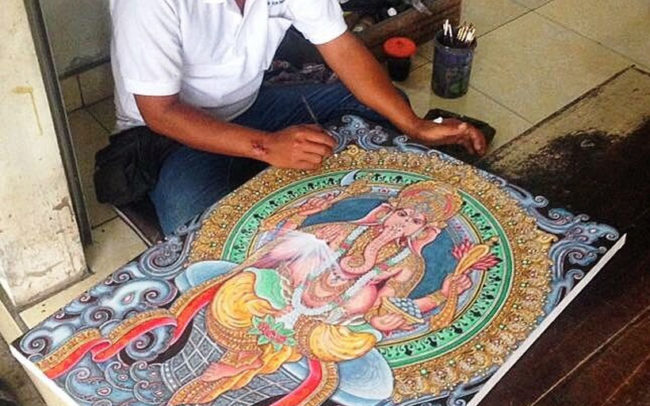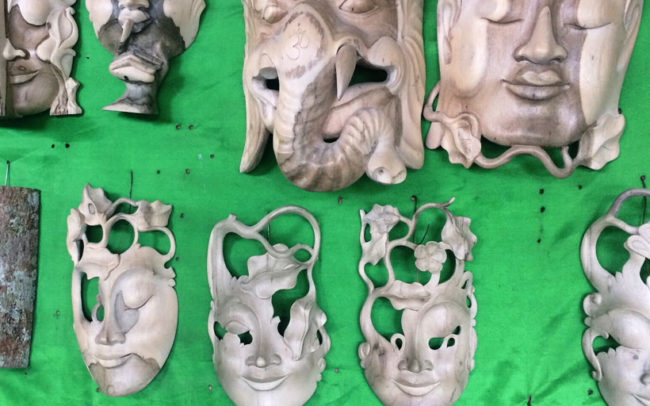My Indonesian travels have brought me here, to Ubud – a spiritual hub in the central highlands of Bali. If people could have towns for soulmates, Ubud would almost certainly be mine. It seems to ooze a contagious culturally creative energy. An energy that is beautifully framed by terraced rice paddies, tropical jungles and volcanic silhouettes.
Far from the island’s world renowned beaches, Ubud seems to attract a different kind of tourist – those who choose to explore humid jungle temples and sit cross legged to watch an ancient Hindu ceremony over sipping cocktails on the sun loungers of Bali’s idyllic beaches. Ambling aimlessly through the town’s quaint streets you soon become consumed by the vivid colours of the traditional dress, the ringing and chanting of ceremonial prayer and the pungent spiritual scents of incense. The ornate, dark stone carvings of traditional family temples stand tightly between modest boutique shops and quirky vegan eateries – a beautiful juxtaposition of the historical and modern faces that cultural Ubud holds dear.
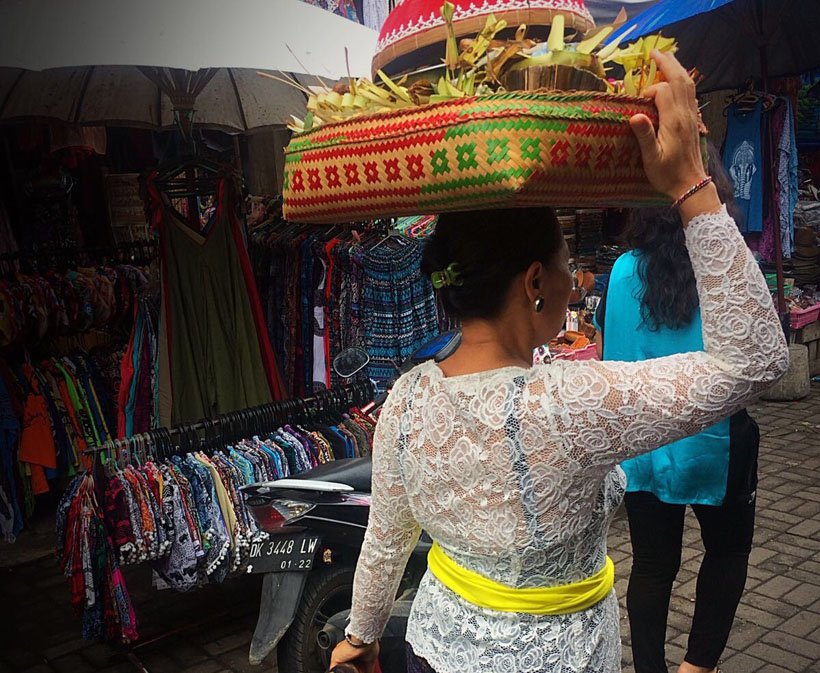
The streets are filled with make-shift art studios, side streets-come galleries and rabbit warrens laiden with ornate handicrafts. As you drive away from central Ubud, stall after stall flashes past the car window, each adorned with specialist wooden carvings, intricate paintings, traditional Balinese kites and decorative lanterns. Even as you make your way out of town by foot for a wander through Ubud’s rustic surroundings, you may find yourself stumbling across some innovative displays of local artwork. A walk along one of its many winding trails through paddie fields led me to admire a haphazard presentation of abstract illustrations. A number of canvases had been mounted on poles and left dotted along the seemingly remote pathway, almost as if they were road signs warning of upcoming danger rather than someone’s inspired work. It feels as though the streets themselves have become a form of gallery, where artwork is displayed on the only stage it’s creator can access – the dramatic Indonesian landscape that surrounds them – and that is, in many cases, also their muse.
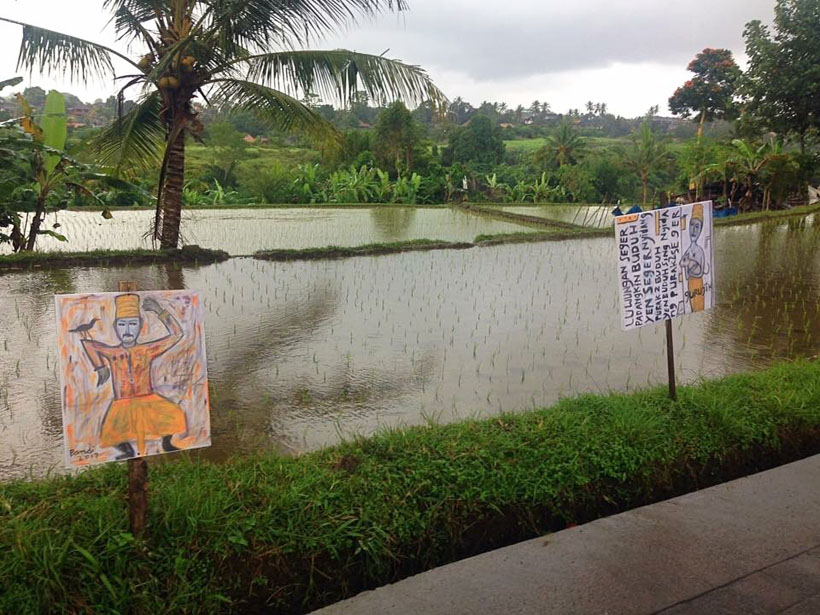
One afternoon, when taking a walk through the rural hills that surround Ubud, I found myself stuck in a sudden tropical downpour. I ran to take cover under a nearby drooping canopy that turned out to be the humble workshop of Kadek, a young sculptor. In typical Balinese fashion, he warmly invited me to sit with him and watch the passing storm. The artist spoke with me about his craft as he sat cross legged, using his toes to balance the chunk of crocodile wood that he was whittling away at with ease. The make-shift studio displayed Kadek’s handiwork – from dainty and delicate Hindu statues that stood by my feet, to great masks that adorned wooden walls. I left the studio to brave the elements once more and found myself running further through the now misty fields, only to see the shadow of another hut in the distance. This time a painter, perched on a tiled floor smiled up at me, then back to his canvas as he blotted at the paint pallet he’d created on his wrinkled hand. I was in awe of the ability these artists had to create raw beauty in such a humble setting, yet it almost felt more special that I had stumbled upon their work by chance rather than in a formal exhibition or gallery. I was able to watch the craftsmen at work and revel in their talent as the sole member of their audience, even if only for a few minutes.
Authentic Balinese culture is celebrated every day in Ubud through ritualistic Kecak performances. Candles and flames are lit before the dramatic Pura Dalem temple, where the Hindu story of Ramayana is relayed in the form of a traditional monkey chant dance. A chorus of over 100 sarong-adorned men sit encircling the performers, chanting a hypnotic trance and building tension. Bold costumes and theatrical make-up compliment the dark temple backdrop in effectively transporting the audience far from the honking horns of Ubud’s traffic lined streets. It is easy to lose yourself in your imagination when visiting this tranquil town – whether that is during a mesmerising dance performance, somehow finding yourself in amongst a lavish festival or in the simple art created by a scattering of colourful offerings.
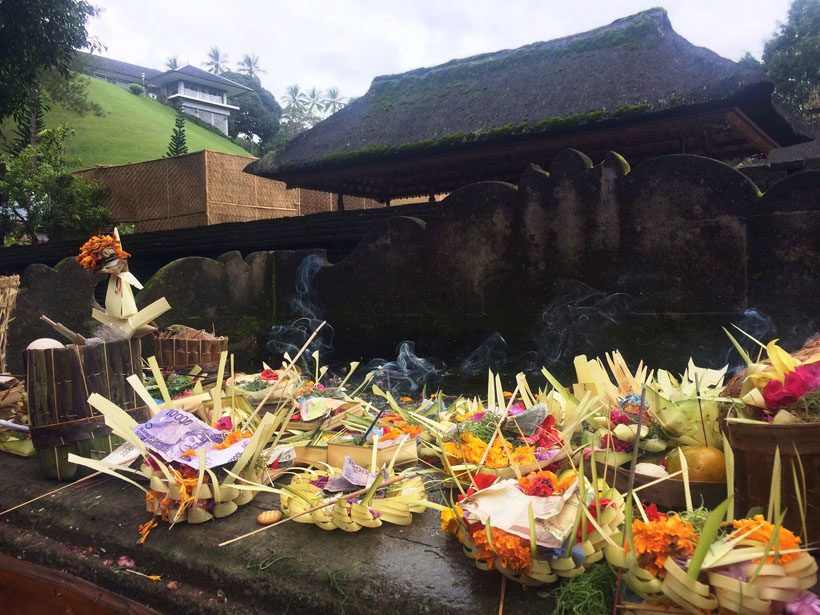
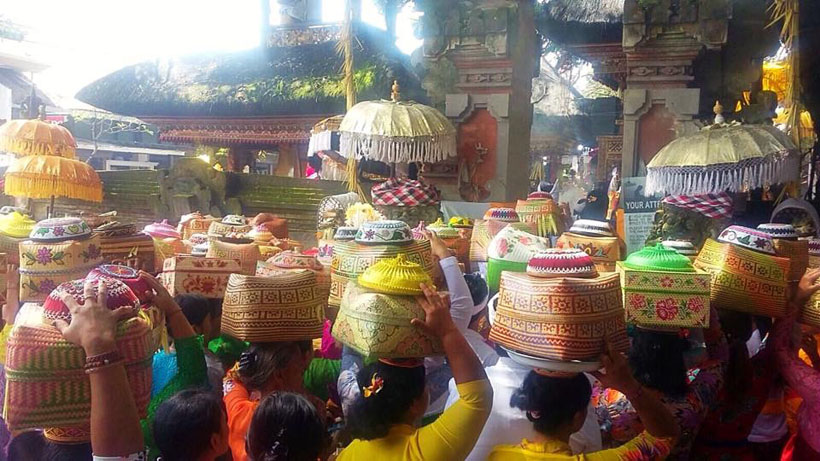
Arts in Bali are very much a celebration of local Indonesian culture – paintings illustrate paddie farmers dotted in amongst their crops, whilst carvings depict Hindu deities and textiles display the traditional symbolism of Batik weaving. During our stay in Ubud, we discovered ‘Threads of Life’ – a fairtrade business that has created independent collectives with over 1,000 weavers in the remote villages of Indonesia. The shop-come-museum sheds a light on cultural techniques which have been handed down from generation to generation – whilst empowering the skilled artists behind this traditional art form, in what has become a competitive contemporary market. The wonderfully niche pieces each tell the story of a Balinese legend. It’s stories like this, of the archipelagos rich heritage, that seem to come hand in hand with so many of the individually crafted pieces adorning the market stalls and galleries. This, in turn, creates a unique and distinct Ubud experience.
If you venture from the highlands down to Bali’s south-easterly coasts, you will find yourself in Sanur. The former tourist hub has quietened in recent years, bringing a subtle serenity to its sandy beaches – where wooden fishing boats sway in the lapping tide and traditional Indonesian kites litter the peaceful skies.
It is here that the Artotel can be found, a modest but growing venture that is dedicated to showcasing local artwork in its 3 Indonesian venues (the others are based in Jakarta and East Java). The contemporary hotel in Sanur takes its guests on a creative Balinese journey – from the more conventional rotating gallery in the hotel foyer, to the extraordinary bold illustrations that adorn the hotel walls and the giant sculptures that hang suspended above our heads.
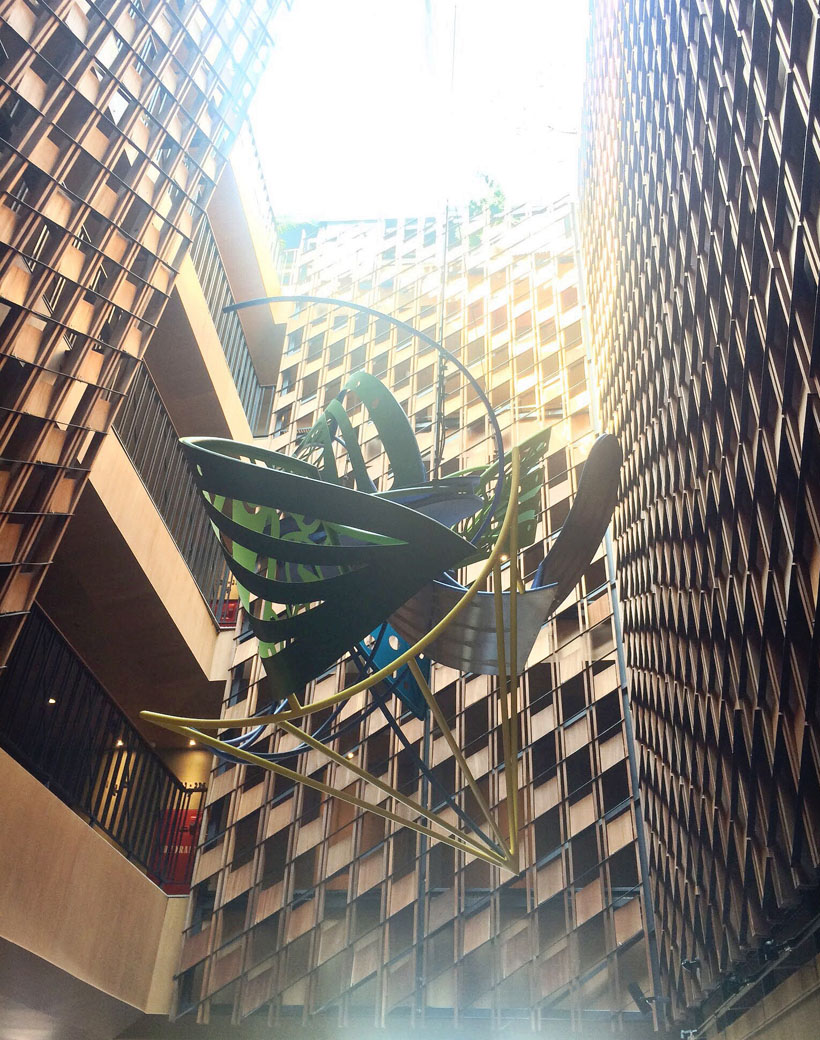
The original design of this Sanur based hotel was inspired by the region’s heritage in crafted kites and its famous kite festival. The full effect of this can be felt as you look from the gallery space to the triangular wooden framing of the walls that seems to flow, almost in waves, as you raise your field of vision up to the great expanse above. This theme is carried through to the canvas canopies of the open roof terrace – akin to the billowing fabric of the traditional Indonesian flag – where you can enjoy the coastal breeze as you take in panoramic views across the ocean.
Local artists were commissioned to design and decorate each of the hotel’s bedrooms. This method has been carried across all Artotel venues, subsequently giving them each a very different artistic feel – one that is representative of that particular creative scene. Their next venture is planned to be in Ubud – a project I’m looking forward to following – where they believe the natural cultural individuality will feed the unique aims of the brand. Much like the Art Hostel in Leeds, Artotel isn’t just about creating a hotel experience, but also about fostering a space for the meeting of similar minds. To encourage not only the sharing of ideas but also building a platform for local artists. One particular creative, backed by Artotel, whose work features in their Jakarta venue, later went on to achieve commissioned work for renowned international brands including Nike.
Artotel provides more than simply somewhere to sleep – using art space to hold events, such as the recent ‘Love is Blind, Huh!’ exhibition. The hotel’s art curator, Safrie Effendi, invited 3 young and emerging artists to interpret this theme and illustrate feelings of love in their own style. Space and time were provided for these local creatives to showcase their talent and to interact with an audience, where they had a platform to share their vision and inspiration. The urban concept of Artotel has been centred around celebrating art in all its forms, of making use of the space within the hotel to share what creativity lies in Indonesia – in this case, Sanur.

The cultural heritage of Bali is emblematic of its arts – whether that be displayed in its art galleries or in its serene temples, through choreographed performances or spiritual daily rituals. Sleepy Sanur stands as a celebration of Balinese tradition. And yet, the urban platform appears, seamlessly, to blend its heritage with the independent and unique face of contemporary Balinese art – where emerging young creatives are encouraged to flex their imagination in new ways.
Whilst Ubud just seems to exhume a kind of spiritual creativity – from grand architecture and extravagantly decorated temples down to the ornate hand-carved patterns of its dark wooden doorways. Ubud is a town where the market stalls display delicate artwork and handicrafts – not just traveling pants and Bintang merchandise – and where the air of the evening streets are filled with the warm tones of live reggae and the rich smell of incense. The urban buzz of Ubud has brought with it a unique artistic energy – which has, much like in Sanur, organically developed to become a creative hub. These Balinese towns have generated the perfect environment fostering imaginative growth and, in turn, have started to act like magnets – drawing in traveling and local artistic minds alike to share in this innovative aura.
Words and images by Emily Baldwin.

